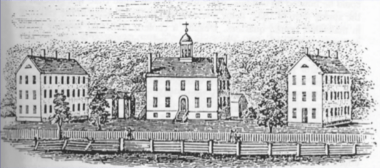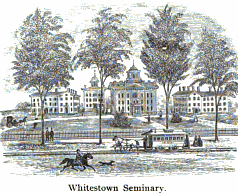Oneida Institute facts for kids
 |
|
|
Other names
|
Oneida Institute of Science and Industry Whitestown Seminary |
|---|---|
| Active | 1827–1843 |
|
Religious affiliation
|
Presbyterian |
| President | George Washington Gale (1827–1833) Beriah Green (1833–1843) |
| Location |
,
,
USA
43°07′10″N 75°17′10″W / 43.1195793°N 75.2861673°W |
| Campus | 114 acres (46 ha) |
The Oneida Institute was a very important school that existed from 1827 to 1843. It was a national leader in the movement to end slavery, known as abolitionism. This school was considered the most forward-thinking in the country. It was the first school where Black men were welcomed as students, just like white men.
The Oneida Institute was located near Utica, in a village called Whitesboro, New York. It was founded in 1827 by George Washington Gale. He named it the Oneida Institute of Science and Industry. The school bought over 100 acres of land for its campus. A lot of the money for the land and buildings came from brothers Arthur and Lewis Tappan, who were famous for helping good causes and fighting against slavery.
Oneida Institute also played a role in a student movement called the "Lane Rebels." About 24 students, led by Theodore Dwight Weld, left Oneida to study at another school, Lane Seminary. Later, they left Lane for Oberlin College, which became very famous. Oneida's first president, George Washington Gale, later started Knox College in Illinois. All these connections show how important Oneida was in the fight against slavery.
Contents
The First President: George Washington Gale
The Oneida Institute opened in May 1827 with two teachers, George Washington Gale and Peletiah Rawson. Rawson was an engineer who had worked on the Erie Canal. The school started with 20 students, including Theodore Dwight Weld. Soon, the number of students grew to 100, and by 1830, 500 students were turned away because there wasn't enough space. In 1829, the school officially became the Oneida Institute of Science and Industry. It was closely connected to the Presbyterian church in Whitesboro.
Oneida was a leading example of a "manual labor college." This meant students combined their studies with physical work. Gale believed that working with their hands was good for both the body and the mind. It also helped make education more affordable. Students worked on the farm or in shops making things like furniture and harnesses. Later, a printing shop was added. For example, in one year, students produced a lot of crops and other goods, which helped the school.
The school also had a strong religious focus. Students studied Hebrew and Biblical Greek instead of Latin and Classical Greek. Gale wanted to train students to become leaders in a Christian movement called "revivalism." Many students became activists who spoke out against alcohol, slavery, and other issues they saw as wrong.
However, Gale wasn't the best leader. In 1832, about 24 students left the school because they were unhappy. Gale soon wanted to leave his position. He moved to Illinois and started a new school, Knox Manual Labor College, which later became Knox College. When Gale left, the Institute had money problems.
The Second President: Beriah Green
After Gale left, the school looked for a new president. They chose Beriah Green, a strong supporter of ending slavery. He started in 1833. Green's personality shaped the school, and it became known as "President Green's school."
What Students Studied
Green changed what students learned at Oneida. He focused more on moral philosophy, which is the study of right and wrong. Like Gale, he replaced Latin and classical Greek with Hebrew and New Testament Greek.
In 1843, the school's "Course of Study" included:
- Greek and Hebrew
- Math subjects like arithmetic, bookkeeping, algebra, and geometry
- Science subjects like anatomy, physiology, and natural philosophy (studying nature)
- Other subjects like natural theology, evidences of Christianity, political economy, and the science of government.
Students also practiced public speaking and writing.
To be accepted, students needed to:
- Have good mental and moral character.
- Be able to teach in a regular English school.
- Understand Greek Grammar.
- Plan to complete the full course of study.
These opportunities were open to all students, not just those planning to become ministers.
Fighting Slavery: Welcoming Black Students
Green's main goal was to train students to become activists against slavery. He believed that ending slavery was a Christian duty. Under Green, Oneida became known as an "abolition college" and a center for anti-slavery activities. It was more focused on ending slavery than any other American college. Local anti-slavery groups were formed, declaring that slavery was a crime and a sin.
Green agreed to become president only if he could preach "immediatism" (the idea that slaves should be freed immediately) and if the school could admit African-American students. Before Green, there were no Black students at Oneida.
In the 1830s, allowing Black students to study with white students was very controversial and often led to violence. For example:
- The Noyes Academy in New Hampshire was destroyed in 1835 after it admitted African-American students. Four of its students then came to Oneida.
- A school for Black girls in Connecticut, run by Prudence Crandall, was forced to close due to violence from townspeople.
Oneida was the first college in the country to admit African-American students without any restrictions. Students like Alexander Crummell said there was "perfect equality" between Black and white students. There were usually 10 to 14 Black students at the school.
In his first speech, Green called for "immediate, unconditional, and uncompensated emancipation." This meant freeing slaves right away, without paying their owners for their "loss."
Money Troubles
When Green became president, the school was in debt. American abolitionists, including Gerrit Smith, promised a lot of money to help the Institute. However, a financial crisis in 1837, called the Panic of 1837, meant that not everyone could keep their promises. This left the Institute with a large debt.
In 1839, Green and the teachers asked for donations in a newspaper called The Colored American.
Student Numbers and Challenges
Before 1840, Oneida usually had about 100 students. Because of the debt, teachers gave up most of their salaries in 1841, and student numbers dropped to 25. The next year, there were 50 to 75 students.
The school's strong anti-slavery stance was not popular with everyone. Education groups stopped giving money to Oneida students because the school focused on Hebrew instead of Latin and was called an "Institute" instead of a "College." In 1834, the Presbyterian Education Society and the American Education Society removed Oneida Institute from their list of approved schools.
In 1836, some New York politicians wanted to stop funding Oneida Institute because they thought it was a "hotbed of sedition" (a place that encouraged rebellion) and that Beriah Green was spreading abolitionist ideas. However, over 150 people protested, demanding academic freedom, and no action was taken.
The Oneida Institute closed in 1843. One reason was that the New York Anti-Slavery Society didn't pay the school for printing their newspaper. Other reasons for its failure included:
- The manual labor system didn't make enough money.
- Replacing classical studies with the Bible made the school seem unusual.
- Treating Black and white students equally and its strong anti-slavery views made it unpopular with many people.
Despite its short life, Oneida Institute influenced many other important schools like Lane Theological Seminary, Western Reserve University, Oberlin College, and Knox College. It also helped pave the way for schools like Bates College.
Whitestown Seminary and Later Years
To pay off its debts, the Oneida Institute's buildings were sold to the Free Will Baptists. They opened the Whitestown Seminary in 1844. A key part of the sale was that the new seminary had to admit students of "all colors." Some students from the Oneida Institute continued their studies there. The Whitestown Seminary later merged with other schools and eventually became part of Bates College.
The original school buildings are no longer standing. Today, the land is used for a factory, a funeral home, and homes.
Students of Oneida Institute
President Green wanted to accept any qualified student. One student described the student body as a "motley company," meaning a very diverse group. It included:
- Boys from Cuba who were against slavery.
- Students of mixed race.
- A Spanish student.
- An Indigenous student named Kunkapot.
- Black men who had been sailors or drivers, and even those who had escaped slavery.
- Sons of American activists.
- Students who easily read Hebrew.
- Enthusiasts, farm workers, and printers.
- And serious students who admired President Green.
African-American Students
- William G. Allen (1820–1888): A lecturer and professor at New-York Central College, the first college to hire African-American professors.
- Amos Beman (1812–1872): An abolitionist and pastor.
- Alexander Crummell (1819–1898): An abolitionist and minister. He was a student at the Noyes Academy before it was destroyed.
- John V. DeGrasse: A physician.
- Amos Noë Freeman (1809–1893): A teacher, minister, and abolitionist.
- Henry Highland Garnet (1815–1882): An escaped slave, abolitionist, minister, and speaker. He was also a student at the Noyes Academy.
- Jermain Wesley Loguen (1813–1872): An escaped slave, abolitionist, and bishop.
- Jacob A. Prime: Stayed at Whitestown Seminary after Oneida closed.
- Thomas Sydney (c. 1818–1841): One of the students from the Noyes Academy.
- Samuel Ringgold Ward (1817–c. 1866): An escaped slave, abolitionist, teacher, minister, and newspaper editor.
- Augustus Washington (c. 1820–1875): A photographer who later moved to Liberia.
- Julia Williams (1811–1870): An abolitionist and future wife of Henry Highland Garnet. She was the only known female student at Oneida, possibly accepted because she came with a group from the Noyes Academy.
Native American Students
- Kunkapot
- William Whipple Warren (1825–1853): A historian and interpreter who was part white and part Ojibwe.
White Students
Some students, influenced by Theodore Dwight Weld, left Oneida for the Lane Theological Seminary. These students were all white.
- John Watson Alvord: A minister and president of the Freedman's Savings Bank.
- Joel Prentiss Bishop (1814–1901): An attorney and writer on legal topics.
- Albert A. Bliss (1812–1893): An Ohio State Treasurer.
- Amos Dresser (1812–1904): He was publicly whipped in Nashville, Tennessee, for having anti-slavery writings.
- Charles Grandison Finney (1792–1875): A famous religious leader and later president of Oberlin College.
- Josiah Bushnell Grinnell (1821–1891): A U.S. Representative from Iowa and founder of Grinnell, Iowa.
- Henry Brewster Stanton (1805–1887): A leading abolitionist and husband of Elizabeth Cady Stanton, who fought for women's voting rights.
- Two sons of abolitionist Lewis Tappan.
- Theodore Dwight Weld (1803–1895): A very important abolitionist. He led the group of students who left Oneida for Lane Seminary and then Oberlin.
- Hiram Wilson (1803–1864): An abolitionist who started a school for escaped slaves in Canada.
Images for kids
-
Daguerreotype of John Brown by Augustus Washington, c. 1846



